1. Introduction
In the optimized design of Yellow Dy³⁺-doped ZBLAN fiber lasers in the 560-600 nm band, the physical significance of the yellow laser is of vital importance. The laser in this band has superior optical properties which fully meet the requirements of efficient laser emission and precise control. Especially after Dy³⁺ are doped into the ZBLAN fiber, because of its special energy level structure, the fiber laser can achieve wide-range wavelength tuning, thereby realizing efficient energy conversion in this window. Yellow Dy³⁺-doped ZBLAN fiber lasers not only can provide high brightness and low threshold power but also can be applied to high brightness and low threshold power. In medicine, yellow lasers can be used for imaging and treatment of biological tissues, especially in ophthalmology and dermatology applications [1-4]. In addition, yellow lasers also play a significant role in lidar, gas detection and environmental monitoring, improving detection accuracy through resonance with specific gases or molecules. By optimizing the doping concentration, pumping wavelength and cavity design of fiber lasers, the performance can be effectively enhanced and their application potential in modern technology can be extremely expanded.
In the research of Dy³⁺ -doped ZBLAN fiber laser, Bolognesi et al. systematically evaluated the performance of Dy³⁺ in Dy,Tb co-doped LiLuF₄ crystals in respect of yellow laser, verified the idea of improving the lower energy level lifetime through Tb³⁺ co-doping to enhance efficiency, and provided a material basis for the development of crystals and on-chip devices [5-9]. Subsequently, Zou et al. used a 450 nm GaN laser diode as the source of pump light and successfully achieved a yellow light output of 1.12 W, increasing the maximum slope efficiency to 33.6% by optimizing the fiber cavity length and adjusting the reflectivity of the output coupling mirror [5]. Finally, Demaimay et al. proposed a Dy³⁺ -doped ZBLAN fiber laser scheme with high brightness 450 nm diode pump to further optimize the pump-cavity matching and mode management to achieve efficient yellow light output [6].
This study optimized the design of the Dy³⁺ -doped ZBLAN fiber laser and investigated the influence doping concentration and cavity length have on the laser efficiency. By adjusting the doping concentration from
2. Model and method
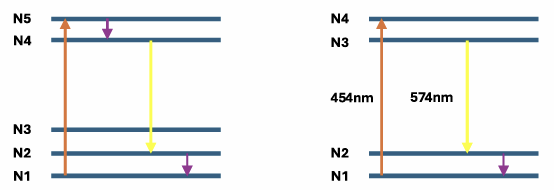
This study simplified the energy level structure of the dysprosium ion (Dy³⁺). Dysprosium ions are generally regarded as a five-level system. In practical applications, especially in the research of yellow lasers, in order to simplify the analysis, this study simplifies its energy level structure into a four-level system, mainly considering the four energy levels of
The simplification process can be visualized in Figure 1.
Under this simplified model, in this study, we focused on the yellow laser emission of dysprosium ions in the 574 nm band. This band is produced by the emission spectrum of dysprosium ions during the ⁴F₉/₂ →⁶H₁₃/₂ transition. In the design of the Dy³⁺ -doped ZBLAN fiber laser, the emission bandwidth of the yellow laser is relatively narrow, which makes it have high application value in high-precision optical sensing, laser display and other fields. In this study, through a simplified four-level model, we were able to effectively analyze the optical properties and laser efficiency in the 574 nm band, providing a theoretical basis for optimizing the design of lasers.
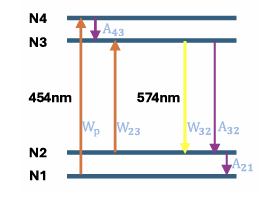
After simplification, we obtain a four-level structure of a dysprosium ion (Dy³⁺) as shown in the above figure 2. The meanings of the above parameters are respectively:
Next, the rate equation can be written based on the energy level system list:
The expressions of each absorption rate and emission rate are as follows:

This figure 3 shows transmission process in a fiber laser, where
Next, the propagation equations of the pump and the laser power can be listed:
Boundary conditions of a linear resonant cavity laser are as follows:
The above formula can be mathematically derived and combined with the boundary conditions to obtain the laser power of fiber laser is
When the laser power of the fiber laser is zero, it can be obtained
Before simulating and solving the differential equation with the aid of MATLAB, the values of each parameter need to be determined first. Referring to relevant literature, as shown in table 1, the following parameter values are adopted in this paper [2].
|
Symbolic |
Physical Parameter |
Numerical |
Units |
|
Central wavelength of the pump light |
453 |
||
|
Wavelength of fiber laser light |
574 |
||
|
Average energy level lifetime |
0.65 |
||
|
The absorption cross-section of the pump light |
|||
|
The emission cross-section of the pump light |
0 |
||
|
The absorption cross-section of fiber laser light |
|||
|
The emission cross-section of fiber laser light |
|||
|
The cross-sectional area of the fiber core |
|||
|
The doping concentration of ions in the core |
|||
|
The loss of laser light by double-clad optical fibers |
|||
|
The loss of pump light by double-clad optical fibers |
|||
|
The length of the double-clad optical fiber |
|||
|
Pump light power filling factor |
|||
|
Laser power fill factor |
|||
|
Reflectivity of the front cavity mirror |
|||
|
Reflectivity of the rear cavity mirror |
3. Results and discussion
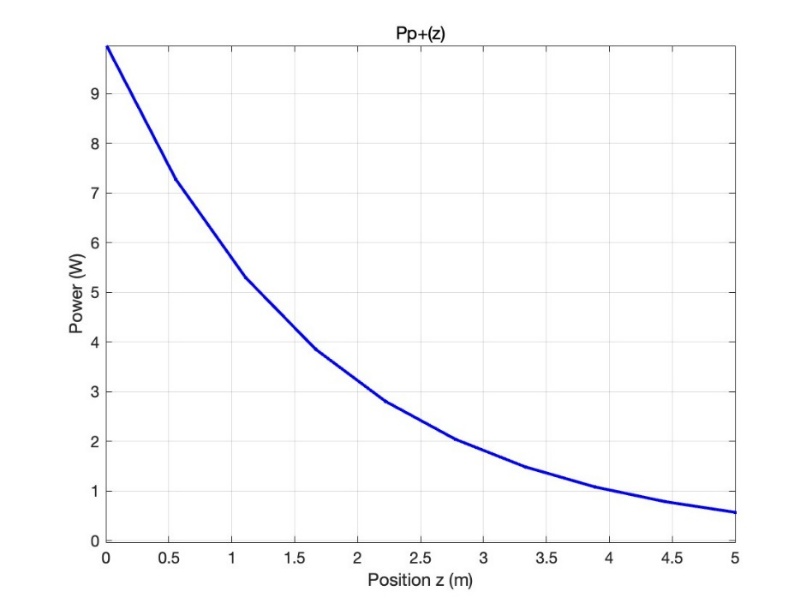
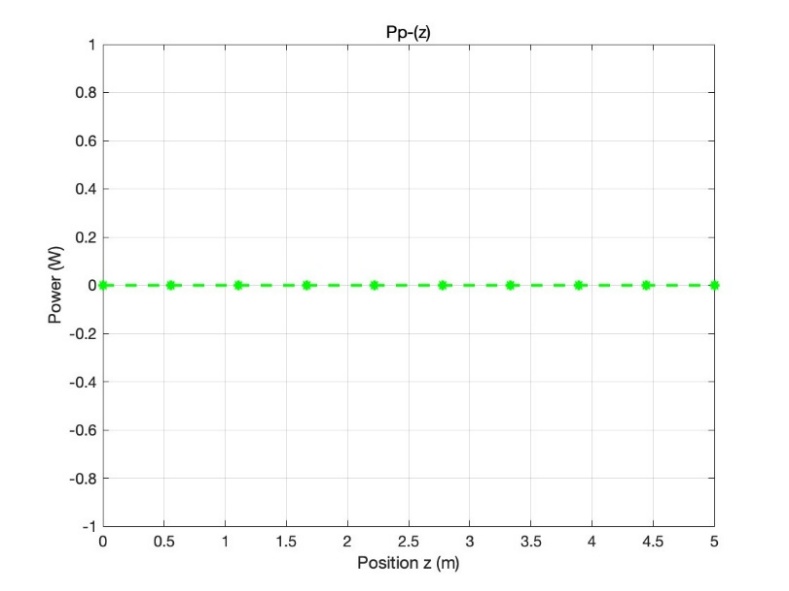
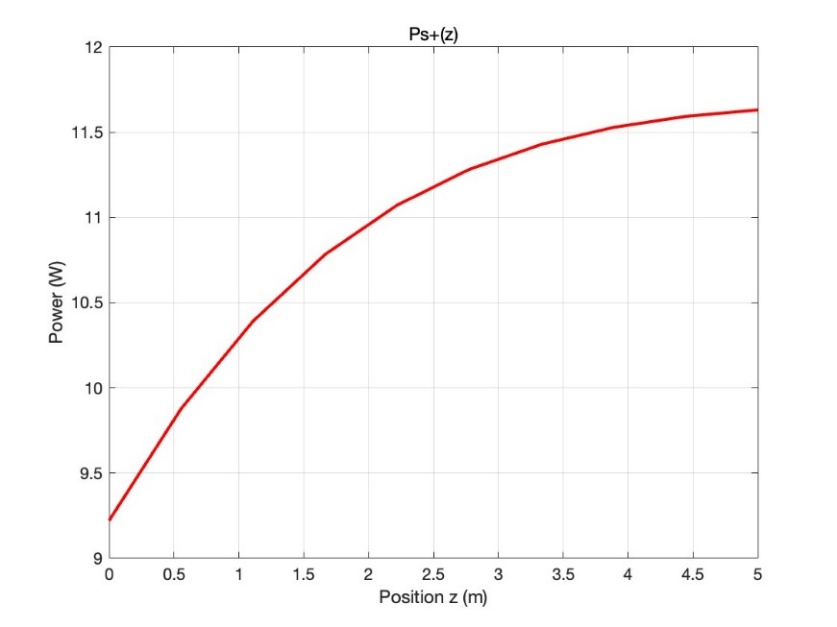
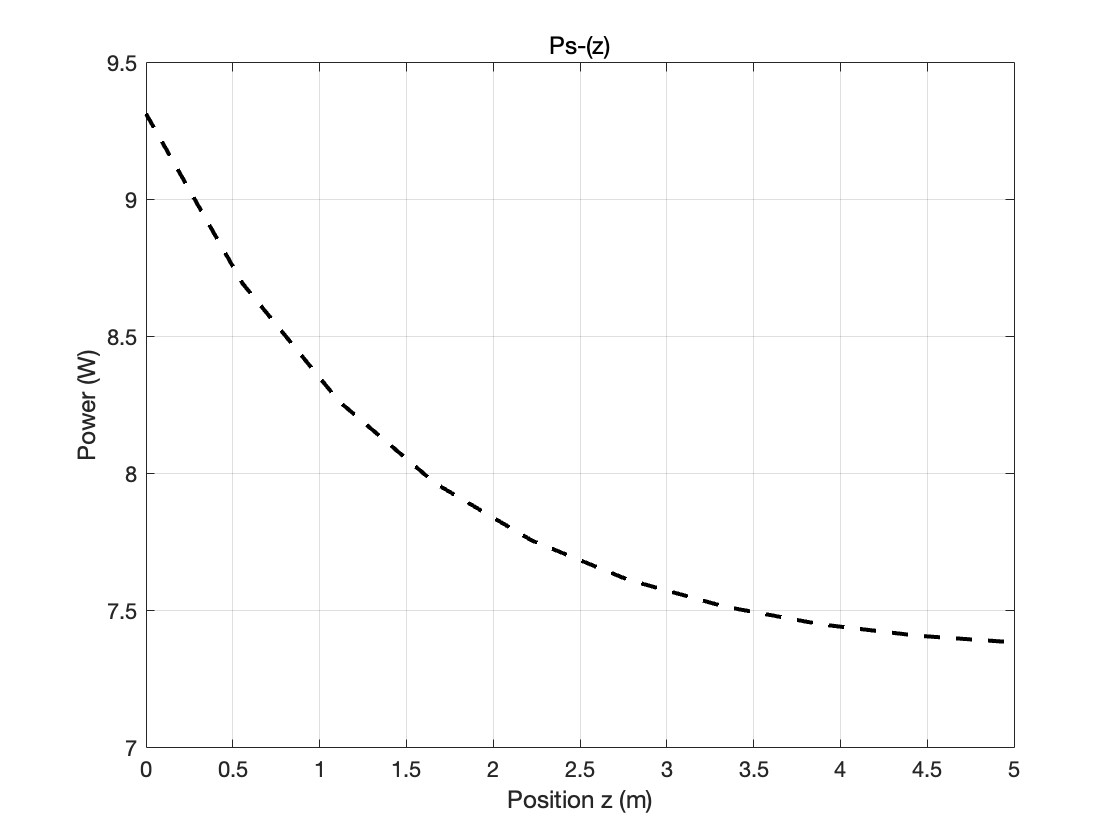
As shown in Figure 4, the forward pump light power decays exponentially and reaches the minimum value
As shown in Figure 6, the forward laser power increases logarithmically and reaches the maximum value
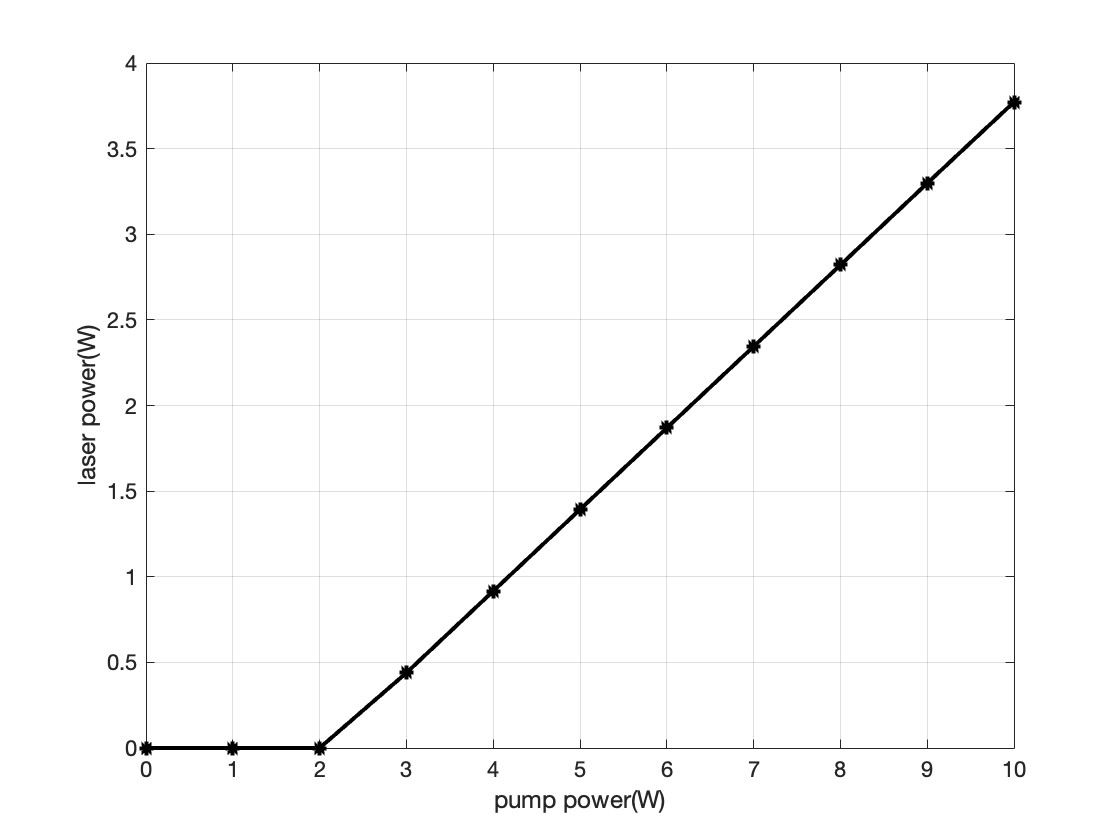
Figure 8 shows the relationship diagram of pump power and laser power. The research range of pump power in this article is between zero and ten watts. When the pump power increases from 0W to 1W, the laser power remains unchanged and is 0. Subsequently when the pump power is increased from 1W to 2W, this increase process is very slow. When the power is between 2 and 10 watts, the laser power increases approximately linearly with the increase of the pump power. We can see that within the range of 0 to 10W, the maximum laser power can reach 3.77W. It is worth noting that when the pump power increases from 0 to 1W, the laser power remains unchanged. The possible reasons are: 1) The optical fiber has losses, and the pump power is lost by the optical fiber; 2) Most of the laser particles are still at lower energy levels and have not been transferred to higher energy levels for further emission. The emitted particles have not completed a complete population inversion.
In this study, the Dy³⁺-doped ZBLAN fiber laser in the 560-600 nm band was optimized and designed, with a focus on the influence of doping concentration and cavity length on the laser efficiency. By optimizing the dysprosium doping concentration and adjusting the fiber cavity length, we found that when the doping concentration and cavity length reached a certain optimal value, the efficiency of the fiber laser was significantly improved, especially in terms of enhancing laser power and stability. The experimental results show that when the doping concentration is
4. Conclusion
The present study assumes uniform fiber doping and constant operating temperature without considering the effects of radial thermal gradient and long-term photodarkening on the efficiency; moreover, the up-conversion loss between pump and signal in the model uses the average value from the literature, which may lead to 5 - 10 % deviation in power prediction. Future work will couple thermo‑electrical‑optical simulations, explore Dy–Ho co‑doping with double‑clad geometries to shorten the cavity and raise the saturation power, and integrate miniature TECs plus full‑fibre packaging to boost environmental robustness. By jointly changing Dy³⁺ concentration and cavity length, this study identifies an optimum of 2.0 × 10²⁵ m⁻³ and 5 m, yielding 3.77W continuous‑wave output at 574 nm with a 30 % external slope efficiency under 10 W of 453 nm pump power, while suppressing any backward pump or signal. The work demonstrates that carefully balancing re‑absorption and population inversion can break the traditional power ceiling of yellow fibre lasers, offering a compact, watt‑level source for biomedical imaging, laser display and atmospheric sensing. Looking ahead, the introduction of co‑doping schemes, energy‑storage pumping and digital‑twin design is expected to push 560–600 nm fibre lasers towards multi‑watt, multifunctional integration and to unlock wider impact in precision medicine and sustainable photonic manufacturing.
References
[1]. Liu, Y., Wang, Y., Wang, M., Shen, H., Huang, C., Wang, X., Gao, J., & Tu, C. (2023). Structure and spectral properties of Dy³⁺ doped CaYAlO₄ single crystal. Scientific Reports, 13, 6066.
[2]. Griebenow, K., Truong, M.-P., Munoz, F., Klement, R., & Galusek, D. (2023). Tuning the fluorescence of Dy³⁺ via the structure of borophosphate glasses. Scientific Reports, 13, 1919.
[3]. Wang, J., Zhu, X., Norwood, R. A., & Peyghambarian, N. (2021). Widely wavelength tunable Dy³⁺/Er³⁺ co-doped ZBLAN fiber lasers. Optics Express, 29(23), 38646–38652.
[4]. Zhao, W., Wen, H., Fan, B., Li, H., & Hao, M. (2019). Preparation and luminescent properties of tunable polychromatic phosphors CaNaB₅O₉: RE³⁺ (RE = Dy, Eu, Tb). Optical Materials, 96, 109274.
[5]. Zou, J., Li, T., Dou, Y., Li, J., Chen, N., Bu, Y., & Luo, Z. (2021). Direct generation of watt-level yellow Dy³⁺-doped fiber laser. Photonics Research, 9(4), 446.
[6]. J. Demaimay et al., (2024) “Efficient yellow Dy: ZBLAN fiber laser with high-brightness diode-pumping at 450 nm, ” Optics Letters, vol. 49, no. 15, p. 4174,
[7]. Ke, L., Cai, X., Ren, K., Zhang, Y. (2024). Color tunability and temperature sensing capabilities in Dy³⁺/Sm³⁺ co-doped transparent oxyfluoride glass ceramics containing K₃YF₆ nanocrystals. Ceramics International, 50(9), 9583–9592.
[8]. Jose, A., Krishnapriya, T., Jose, T. A., Joseph, C. (2021). Tunable luminescence and realization of warm white light via energy transfer from Dy³⁺/Er³⁺/Sm³⁺ triply doped glasses for photonic applications. Journal of Luminescence, 233, 117963.
[9]. G. Bolognesi et al., “Yellow laser performance of Dy^3+ in co-doped Dy, Tb: LiLuF_4, ” Optics Letters, vol. 39, no. 23, p. 6628, Nov. 2014,
[10]. Xia, Z., Li, M., Wang, Z. (2014). Color-tunable emission and energy transfer studies in GdOBr: Ce³⁺ Dy³⁺ phosphor. Optical Materials, 36(4), 670–674.
Cite this article
Zou,P. (2025). Design of ZBLAN Dy³⁺-Doped Fiber Laser in the 560-600nm Band. Applied and Computational Engineering,182,25-34.
Data availability
The datasets used and/or analyzed during the current study will be available from the authors upon reasonable request.
Disclaimer/Publisher's Note
The statements, opinions and data contained in all publications are solely those of the individual author(s) and contributor(s) and not of EWA Publishing and/or the editor(s). EWA Publishing and/or the editor(s) disclaim responsibility for any injury to people or property resulting from any ideas, methods, instructions or products referred to in the content.
About volume
Volume title: Proceedings of CONF-FMCE 2025 Symposium: AI and Machine Learning Applications in Infrastructure Engineering
© 2024 by the author(s). Licensee EWA Publishing, Oxford, UK. This article is an open access article distributed under the terms and
conditions of the Creative Commons Attribution (CC BY) license. Authors who
publish this series agree to the following terms:
1. Authors retain copyright and grant the series right of first publication with the work simultaneously licensed under a Creative Commons
Attribution License that allows others to share the work with an acknowledgment of the work's authorship and initial publication in this
series.
2. Authors are able to enter into separate, additional contractual arrangements for the non-exclusive distribution of the series's published
version of the work (e.g., post it to an institutional repository or publish it in a book), with an acknowledgment of its initial
publication in this series.
3. Authors are permitted and encouraged to post their work online (e.g., in institutional repositories or on their website) prior to and
during the submission process, as it can lead to productive exchanges, as well as earlier and greater citation of published work (See
Open access policy for details).
References
[1]. Liu, Y., Wang, Y., Wang, M., Shen, H., Huang, C., Wang, X., Gao, J., & Tu, C. (2023). Structure and spectral properties of Dy³⁺ doped CaYAlO₄ single crystal. Scientific Reports, 13, 6066.
[2]. Griebenow, K., Truong, M.-P., Munoz, F., Klement, R., & Galusek, D. (2023). Tuning the fluorescence of Dy³⁺ via the structure of borophosphate glasses. Scientific Reports, 13, 1919.
[3]. Wang, J., Zhu, X., Norwood, R. A., & Peyghambarian, N. (2021). Widely wavelength tunable Dy³⁺/Er³⁺ co-doped ZBLAN fiber lasers. Optics Express, 29(23), 38646–38652.
[4]. Zhao, W., Wen, H., Fan, B., Li, H., & Hao, M. (2019). Preparation and luminescent properties of tunable polychromatic phosphors CaNaB₅O₉: RE³⁺ (RE = Dy, Eu, Tb). Optical Materials, 96, 109274.
[5]. Zou, J., Li, T., Dou, Y., Li, J., Chen, N., Bu, Y., & Luo, Z. (2021). Direct generation of watt-level yellow Dy³⁺-doped fiber laser. Photonics Research, 9(4), 446.
[6]. J. Demaimay et al., (2024) “Efficient yellow Dy: ZBLAN fiber laser with high-brightness diode-pumping at 450 nm, ” Optics Letters, vol. 49, no. 15, p. 4174,
[7]. Ke, L., Cai, X., Ren, K., Zhang, Y. (2024). Color tunability and temperature sensing capabilities in Dy³⁺/Sm³⁺ co-doped transparent oxyfluoride glass ceramics containing K₃YF₆ nanocrystals. Ceramics International, 50(9), 9583–9592.
[8]. Jose, A., Krishnapriya, T., Jose, T. A., Joseph, C. (2021). Tunable luminescence and realization of warm white light via energy transfer from Dy³⁺/Er³⁺/Sm³⁺ triply doped glasses for photonic applications. Journal of Luminescence, 233, 117963.
[9]. G. Bolognesi et al., “Yellow laser performance of Dy^3+ in co-doped Dy, Tb: LiLuF_4, ” Optics Letters, vol. 39, no. 23, p. 6628, Nov. 2014,
[10]. Xia, Z., Li, M., Wang, Z. (2014). Color-tunable emission and energy transfer studies in GdOBr: Ce³⁺ Dy³⁺ phosphor. Optical Materials, 36(4), 670–674.









